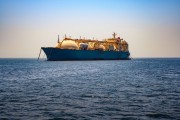“A promise made. A promise kept.” That’s been a main message from the B.C. Liberals celebrating the one-year anniversary of their 2013 election victory. But when it comes to their promise to produce the “cleanest liquefied natural gas (LNG) in the world,” a better phrase might be “A promise made. A promise redefined.”
The most recent redefinition came from the province’s Minister of Natural Gas Development, Rich Coleman. Earlier in May, he said the government is now setting its environmental standards for LNG based on gas-powered terminals. Originally, the government said these terminals would rely on renewable electricity, which would have a lower environmental impact.
This back-step follows one by Premier Clark last year. Instead of focusing on the entire LNG industry, which would include fracking in the northeast, Clark said her promise only applied to the liquefaction terminals on the coast. Taken together, the weakened promise of “cleanest LNG in the world” could mean B.C. develops an LNG industry that’s little better than business as usual.
To illustrate, imagine if we took this approach in hockey. We expect Team Canada to be the best team in the world. We don’t put that onus entirely on the goalie, and then move the goal posts closer together. “Best” with an asterisk doesn’t cut it on the ice; nor should it when it comes to safeguarding a healthy environment.
When announced in early 2012, “cleanest LNG in the world” didn’t come with caveats, asterisks or fine print. It was a simple and potentially effective promise.
The province’s LNG strategy reads: “LNG development in B.C. will have lower life cycle greenhouse emissions than anywhere else in the world.” Not much ambiguity there. This means that any LNG produced in B.C. should create less carbon pollution than LNG produced in Qatar, Australia, Norway, or wherever else it might come from.
Premier Clark introduced the first caveat when she said the promise didn’t apply to impacts in northeast B.C., even though that’s a big part of the LNG industry. The terminals (predominantly located in Prince Rupert or Kitimat) would be large industrial facilities that merit strong environmental standards. The Pacific Northwest LNG project, for example, would produce over five million tonnes of carbon pollution — three times more than B.C.’s current largest polluter.
But limiting the scope of environmental impacts from LNG to the terminals is like worrying about your goalie’s performance while ignoring the rest of the team. The full LNG line up includes gas wells, pipelines, compressors, processing plants, and other infrastructure needed to supply terminals. Taking the Pacific Northwest LNG example, that additional carbon pollution from the gas supply could be more than double what the terminal would produce — depending on how it is developed.
Drawing an artificial boundary around B.C.’s northwest excludes opportunities to reduce impacts outside of it. Carbon capture and storage, for example, is a technology that LNG operations in Norway and Australia are already using and investing in to lower carbon pollution from gas production. B.C. could do the same, if it expanded its focus.
Now even the bar for LNG terminals appears to be dropping. Minister Coleman’s recent comments mean the province will no longer require companies building liquefaction terminals to compare their projects against the best possible option.
In terms of air and carbon pollution, the best LNG terminals would use renewable electricity. One proponent, Woodfibre LNG in Squamish, has decided to use renewables anyway, but they’re the only one to date.
As Minister Coleman has argued, renewables might not be a feasible option for all terminals, but that’s not a good reason to lower the bar across the board. If proponents can’t find ways of meeting this standard, they could make up for it by investing in environmental solutions in other parts of the province.
B.C. Environment Minister Mary Polak acknowledged that if companies couldn’t directly reduce their carbon pollution, they’d be able to pay into a fund to make up for the gap. But these investments into improvements at terminals, or payments into an environmental fund, only happen if the province keeps a high bar.
So, in the two years that LNG has been on the political radar in B.C., the environmental standards have been lowered twice. With years to go before any LNG leaves the province, that’s a troubling trend.
Yet environmental policies for LNG haven’t been finalized; there’s still time to move that bar back up. The promise of “cleanest LNG in the world” can be a promise kept and it can still mean something that British Columbians can be proud of.




